This blog contains affiliate links. As part of afiiliate networks and as an Amazon Associate, I earn from qualifying purchases. If you make a purchase through these links, I may earn a small commission at no additional cost to you. I only recommend products and services that I believe in and have personally used or researched. Your support helps me continue to provide quality content—thank you!
If you’re in the market for a microscope, you’ve come to the right place. This guide covers the top AmScope models of 2025, showcasing options that cater to both beginners and seasoned users. From versatile compound microscopes to specialized stereo models, we’ve got something for everyone. Each selection is built for performance and reliability, but you’ll want to know what fits your needs best. Let’s explore these exceptional choices further.
AmScope B120C Series LED Binocular Compound Microscope
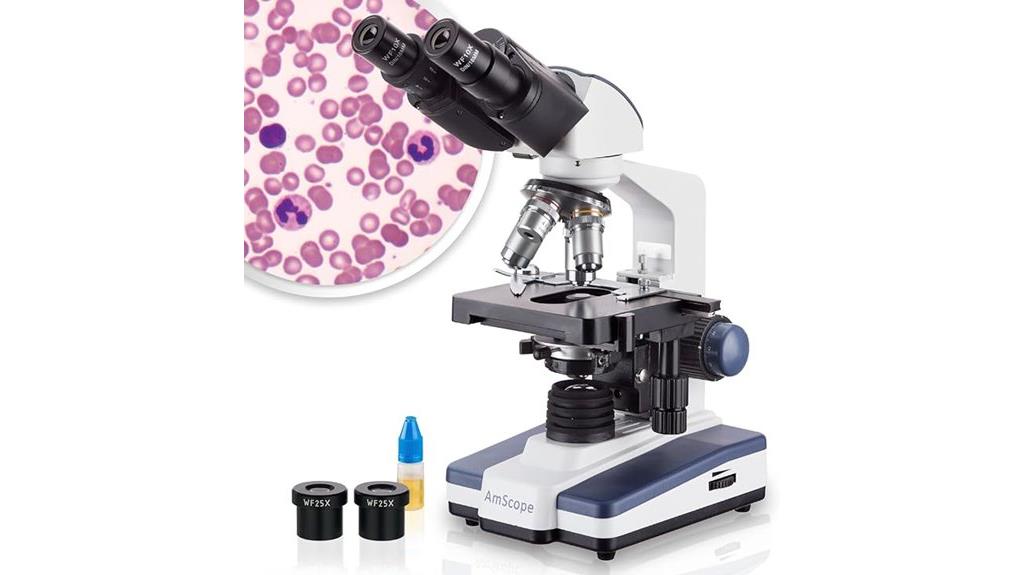
The AmScope B120C Series LED Binocular Compound Microscope is an excellent choice for students and educators seeking a reliable tool for biological studies. With magnification ranging from 40X to 2500X, you can closely examine various specimens like bacteria and plant cells. The binocular head features adjustable interpupillary distance for your comfort, while the 360-degree rotational design enhances usability. Equipped with energy-efficient LED lighting and an iris diaphragm, you can control light intensity effectively. The double-layer mechanical stage and coaxial focus knobs allow for precise adjustments, making this microscope a high-quality option for labs and classrooms alike.
Best For: Students, educators, and hobbyists seeking a robust microscope for biological studies and educational purposes.
Pros:
- Durable construction ensures long-lasting use in educational settings.
- High magnification range (40X to 2500X) allows detailed examination of various specimens.
- Energy-efficient LED lighting provides bright illumination while minimizing heat.
Cons:
- Initial setup may require some time to adjust the focus and lighting settings properly.
- Heavier design may not be as portable for field use compared to lighter models.
- Limited warranty coverage might not satisfy all users’ expectations for long-term support.
AmScope M150 Series Portable LED Monocular Student Compound Microscope
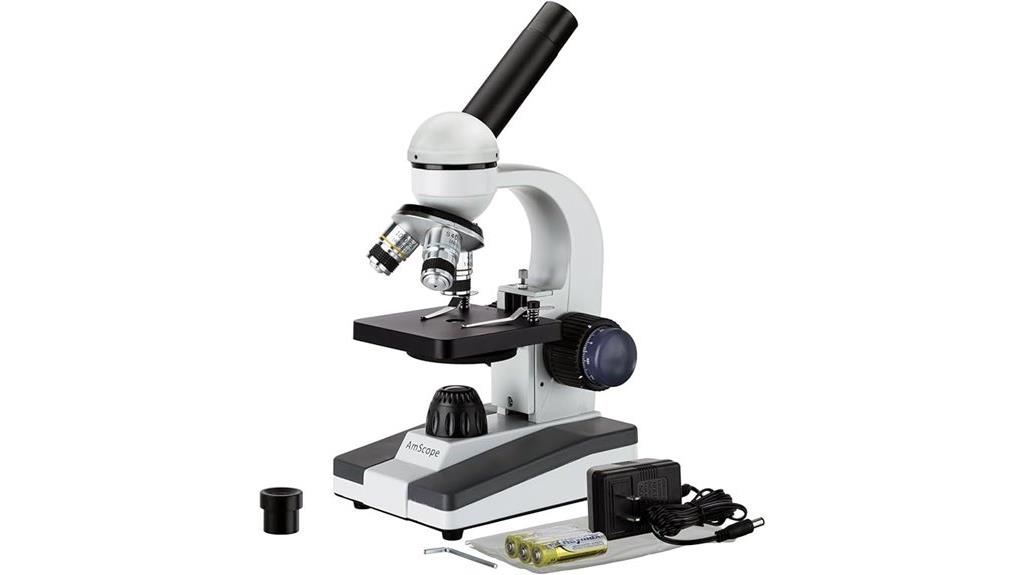
Ideal for students and budding scientists, the AmScope M150 Series Portable LED Monocular Student Compound Microscope stands out with its user-friendly design and extensive magnification options ranging from 40X to 1000X. Its robust all-metal framework guarantees durability, while the LED illumination system enhances visibility, making it perfect for viewing various specimens. You’ll appreciate the adjustable light apertures, distinct focus knobs, and a stable stage with slide clips for efficient handling. With a solid customer rating of 4.5 stars, this microscope is highly regarded for quality and value, although some users have mentioned a need for improved lighting solutions.
Best For: Students and entry-level users interested in exploring the microscopic world.
Pros:
- Robust all-metal construction ensures durability and reliable use.
- Versatile magnification options ranging from 40X to 1000X allow for detailed specimen analysis.
- User-friendly features such as distinct focus knobs and adjustable light settings enhance the overall experience.
Cons:
- Some users reported limitations in higher magnification due to insufficient LED light brightness.
- Lighting solutions may need improvement for optimal visibility in certain applications.
- Lack of storage or carrying solutions for ease of transport and organization.
AmScope Professional Trinocular Stereo Zoom Microscope (SM-4TZ-144A)
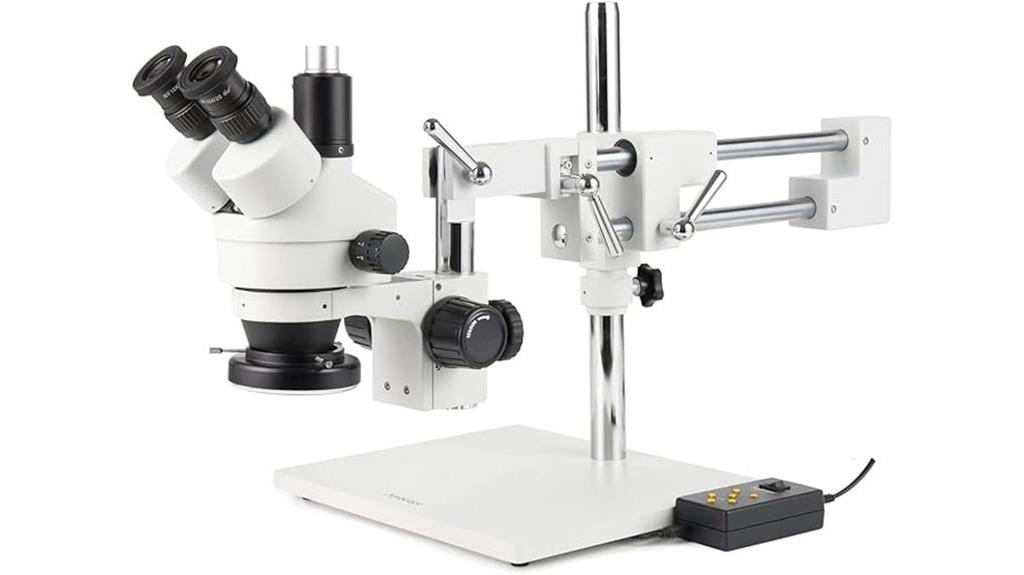
For professionals seeking precision in their work, the AmScope Professional Trinocular Stereo Zoom Microscope (SM-4TZ-144A) shines with its continuous zoom magnification, offering a range of 3.5X to 90X. Its trinocular head allows for easy sharing and includes adjustable eyepieces perfect for glasses wearers. The microscope’s double-arm boom stand provides exceptional flexibility on all axes, and its four-zone LED ring light guarantees bright, shadow-free illumination. Designed for various applications in education, research, and engineering, this microscope combines versatility with quality, making it an excellent choice for any serious enthusiast or professional looking to enhance their observational capabilities.
Best For: This microscope is best for professionals and enthusiasts in fields such as education, research, biology, engineering, and medical applications who require high precision and versatile observation capabilities.
Pros:
- High magnification range (3.5X to 90X) allows for detailed inspection of a wide variety of specimens.
- Adjustable trinocular viewing head makes it easy to share observations and accommodates users wearing glasses.
- Four-zone LED ring light provides bright, adjustable, and shadow-free illumination ideal for temperature-sensitive specimens.
Cons:
- Weight (0.01 ounces) may be misleading, as the stand and components could be heavier and less portable than expected.
- Price point may be on the higher side for casual users or hobbyists.
- Complex setup may require a learning curve for first-time users or those unfamiliar with advanced microscopes.
AmScope Beginner Microscope STEM Kit (M30-ABS-KT2-W)
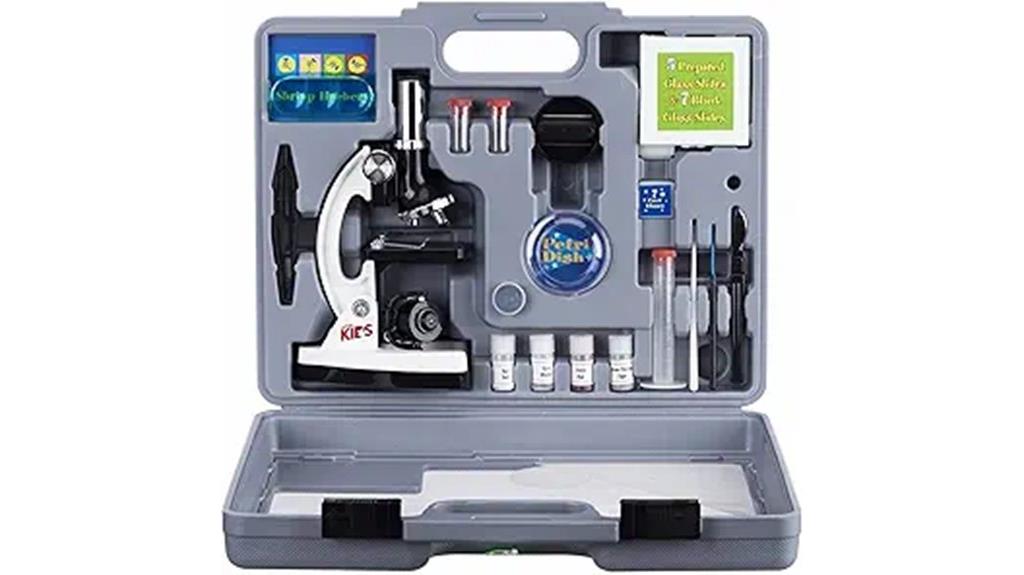
Perfect for young scientists enthusiastic to explore the microscopic world, the AmScope Beginner Microscope STEM Kit (M30-ABS-KT2-W) offers an impressive magnification range from 120X to 1200X with six adjustable settings. It features a durable monocular viewing head and provides LED and mirror illumination, enhancing your viewing experience. The coaxial coarse focus allows for precise adjustments, while the plain stage with clips keeps slides secure. This 52-piece kit includes essential tools like brine shrimp eggs and prepared slides, making it a fantastic choice for budding biologists. Plus, its lightweight design guarantees easy portability for your scientific adventures.
Best For: young scientists looking to engage in hands-on exploration of the microscopic world.
Pros:
- Features a wide magnification range from 120X to 1200X, suitable for various specimens.
- Includes a comprehensive 52-piece accessory kit, enhancing the exploration experience.
- Lightweight and portable design makes it easy for kids to take on scientific adventures.
Cons:
- Some components may feel light or flimsy, impacting perceived quality.
- Limited advanced features may require upgrading for more serious studies.
- Occasional defects reported, though customer service is responsive for replacements.
AmScope SE306R-P-LED Binocular Stereo Microscope
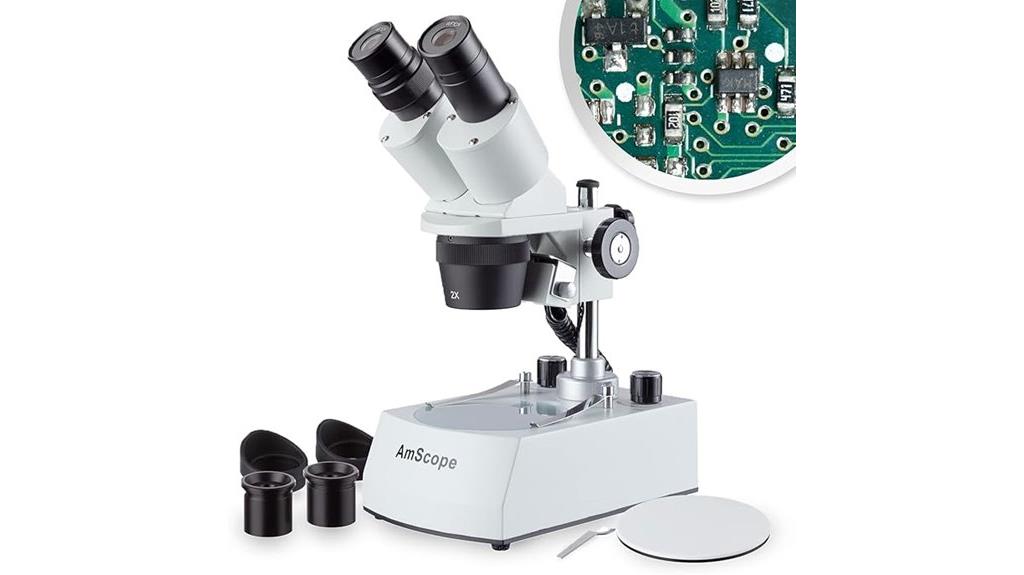
The AmScope SE306R-P-LED Binocular Stereo Microscope stands out as an excellent choice for students and hobbyists enthusiastic to explore the microscopic world. With magnifications of 20x and 40x, it offers clear, three-dimensional images, essential for close inspections. The forward-mounted binocular head enhances comfort, while the adjustable LED lighting guarantees visibility for various specimens. Plus, its all-metal construction assures durability. Ideal for educational and professional settings alike, this microscope allows you to examine everything from biological specimens to jewelry. Users appreciate its ease of use, making it a top pick for anyone looking to investigate microscopy.
Best For: Students, hobbyists, and professionals seeking a versatile microscope for observing and inspecting a variety of specimens.
Pros:
- Offers clear, three-dimensional images with magnifications of 20x and 40x for detailed inspections.
- Durable all-metal construction ensures long-lasting use, while the adjustable LED lighting enhances visibility.
- User-friendly design with a forward-mounted binocular head and dioptric adjustment for comfort.
Cons:
- Some users have reported mixed feedback on build quality and optical performance.
- May not meet the demands of professional-grade applications compared to higher-end microscopes.
- Battery operation requires frequent replacements, which may be inconvenient for users expecting longer usage times.
Factors to Consider When Choosing AmScope Microscopes
When you’re selecting an AmScope microscope, consider factors like magnification range, microscope type, and the quality of the illumination system. You also want to think about the durability of the materials and how you’ll be using it. Each of these elements plays a key role in finding the right fit for your needs.
Magnification Range Selection
Selecting the right magnification range for your AmScope microscope is essential to guarantee you can observe your specimens in the detail you need. If you’re a beginner, a microscope with versatile settings from 40X to 400X can help you explore various sample types effectively. For educational purposes, models offering up to 1000X are typically suitable, while advanced researchers may want options that exceed 2500X for in-depth biological studies. Consider microscopes with multiple objective lenses, allowing you to switch magnifications quickly, which enhances flexibility and efficiency. Finally, keep in mind that monocular scopes usually provide lower magnification limits compared to binocular or trinocular models, which cater better to detailed viewing sessions and longer observations.
Microscope Type Preference
Choosing the right type of AmScope microscope is crucial for maximizing your observation experience. Start by considering the magnification range that suits your needs—beginner models offer up to 1200X, while professionals may require up to 2500X for intricate details. Think about the microscope’s design; binocular, monocular, and trinocular types differ in comfort and usability, especially during extended sessions. If you’re headed outdoors, portability is essential; some models come with dual power options for versatility. Also, look into durability; all-metal frameworks and optical glass lenses typically offer better longevity. Finally, match the microscope to your specific application, whether educational, hobbyist, or research-focused, to guarantee you get the right features for superior performance.
Illumination System Quality
The quality of the illumination system is as important as the type of microscope you pick. A high-quality system enhances specimen visibility with bright, cool light, essential for temperature-sensitive samples. Look for LED illumination, which often allows you to adjust brightness and light aperture, optimizing conditions for your specific specimens. Multiple light sources, including upper and lower illumination, boost versatility and help you view both opaque and transparent specimens effectively. Long-lasting LED lights can offer up to 100,000 hours of use, minimizing replacement needs and ensuring consistent output. Additionally, having efficient light intensity control through features like iris diaphragms markedly improves image contrast and clarity, vital for detailed observations under the microscope.
Build Material Durability
When considering an AmScope microscope, the durability of its build materials plays a critical role in your investment. Microscopes constructed with all-metal frameworks typically boast enhanced strength, standing up well against wear and tear. If you plan to use your microscope in educational or field settings, robust materials can prevent damage from accidental drops or rough handling. Stain-resistant materials help keep your microscope looking professional despite frequent use, while high-quality optical glass guarantees clear viewing and longevity of the lenses. Additionally, a sturdy frame design, along with durable components like stage clips and focus knobs, will allow for frequent adjustments without affecting the microscope’s integrity, assuring you get the most out of your purchase.
Intended Usage Scenario
Several factors play an essential role in how you select your AmScope microscope based on its intended usage scenario. If you’re aiming for educational purposes, models like the M150 or B120C are perfect for introducing students to biological studies with varying magnifications. For lab research or professional use, opt for a model like the SM-4TZ-144A, featuring higher magnification and advanced capabilities like continuous zoom. Consider portability; the M150 Series offers dual power options, which is great for field studies. If you need stereo microscopy for three-dimensional imaging, especially in engineering or forensic applications, that’s key as well. Finally, think about illumination; LED lighting enhances visibility, while higher magnifications may require better light management for ideal viewing.

Erzsebet Frey (Eli Frey) is an ecologist and online entrepreneur with a Master of Science in Ecology from the University of Belgrade. Originally from Serbia, she has lived in Sri Lanka since 2017. Eli has worked internationally in countries like Oman, Brazil, Germany, and Sri Lanka. In 2018, she expanded into SEO and blogging, completing courses from UC Davis and Edinburgh. Eli has founded multiple websites focused on biology, ecology, environmental science, sustainable and simple living, and outdoor activities. She enjoys creating nature and simple living videos on YouTube and participates in speleology, diving, and hiking.
🌿 Explore the Wild Side!
Discover eBooks, guides, templates and stylish wildlife-themed T-shirts, notebooks, scrunchies, bandanas, and tote bags. Perfect for nature lovers and wildlife enthusiasts!
Visit My Shop →
